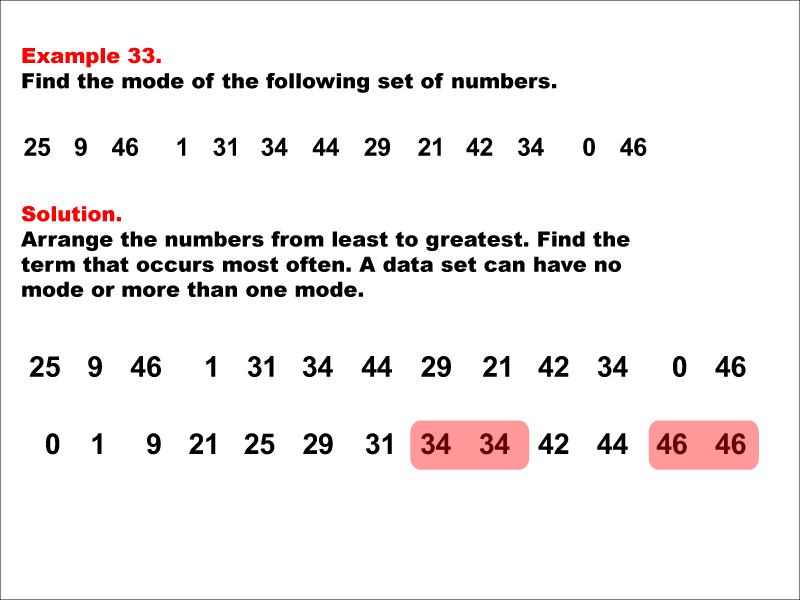
Display Title
Math Example--Measures of Central Tendency--Mode: Example 33
Display Title
Math Example--Measures of Central Tendency--Mode: Example 33

Topic
Measures of Central Tendency
Description
This example showcases a situation of measures of central tendency, where the goal is to identify a key summary measure in a set of data. The image shows an example problem asking to find the mode of a set of numbers. The numbers are listed and then rearranged from least to greatest. The mode is highlighted in red. This example demonstrates that a data set can have multiple modes, even when it contains both positive and negative numbers.
Measures of Central Tendency lessons are instrumental in providing students with a better understanding of how to interpret data through these examples. Each example highlights distinct scenarios which reinforce the concept of determining frequency of occurrences within given sets, enhancing students' analytical skills.
Seeing multiple worked-out examples is crucial in solidifying a student's grasp on a concept. Each example contributes unique perspectives and challenges that can arise when thinking about data sets. This varied approach not only caters to diverse learning styles but also ensures that all students can see the relevance of these concepts in their learning journey.
Teacher's Script
In this example, we're presented with another set of numbers: 25, 9, 46, 1, 31, 34, 44, 29, 21, 42, 34, 0, and 46. Our task is to find the mode. As we arrange these numbers from least to greatest, we notice something interesting – two numbers appear more frequently than the others. Can you spot them? That's right, both 34 and 46 appear twice, while all other numbers appear only once. This means we have two modes: 34 and 46. This situation is called a bimodal distribution. It's a great example of how real-world data can sometimes have more than one 'most frequent' value. In practical terms, this could represent a situation where we have two distinct groups or trends in our data. For instance, if these were test scores, it might suggest two common performance levels among students.
For a complete collection of math examples related to Measures of Central Tendency click on this link: Math Examples: Measures of Central Tendency: Mode Collection.
| Common Core Standards | CCSS.MATH.CONTENT.6.SP.B.4, CCSS.MATH.CONTENT.6.SP.A.3, CCSS.MATH.CONTENT.HSS.ID.A.2, CCSS.MATH.CONTENT.HSS.ID.A.3 |
|---|---|
| Grade Range | 6 - 12 |
| Curriculum Nodes |
Algebra • Probability and Data Analysis • Data Analysis |
| Copyright Year | 2014 |
| Keywords | data analysis, tutorials, measures of central tendency, mode, average |